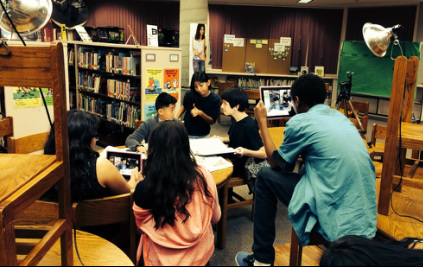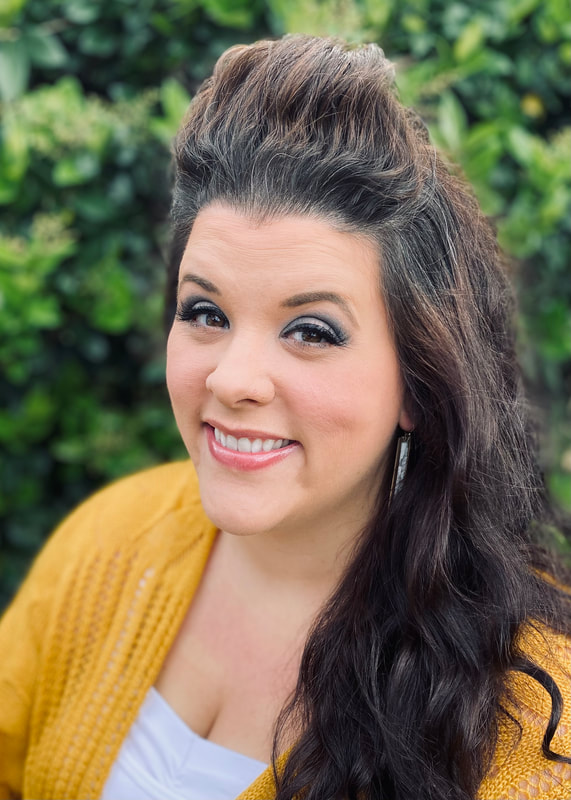|
The library is eerily quiet when we enter, and the students are all business, their voices hushed, as they quickly set about rearranging furniture. The digital clock on the wall reads 3:30, and on a Friday afternoon, when school dismisses at 1:50, the library is one of the last places one would expect to see students. Jebari claps his hands to get the attention of the principle cast, while the crew adjusts their 3-point lighting. “Okay,” he says to his peers. “We are on location here until 4:30 today. Let’s make it count, and do this just like we rehearsed.” With that, they are off and running. And that, as seen through the tiniest of authentic vignettes, is the power of digital storytelling. I’ve been making movies with middle school students for the last seven years, and I have to say that student film is one of the most important pillars of my classroom. In room 208, students have opportunities to tell digital stories throughout the year, both in my core content classes (6th grade Language Arts and Social Studies), as well as in the video production and leadership elective class that I have developed. Giving students the chance to realize their potential as authors and producers of original content is one of the most significant things I can do as a teacher. The Common Core of Student Film According to the Common Core Mission Statement, “…standards are designed to be robust and relevant to the real world, reflecting the knowledge and skills that our young people need for success in college and careers.” In the workplace students will need to be able to collaborate, communicate, create, and think critically. Productive members of the workplace must be able to clearly articulate themselves in both speaking and writing; actively listen to others as part of a collaborative environment; persistently problem solve through careful analysis; and create original content. Digital storytelling is the perfect vehicle to develop these skills in our students today. See Common Core Standards The writers of Common Core seem to understand the role technology plays in the dissemination of information and the self-publishing of work. The Common Core Writing strand 6 (K-12 literacy standards) says students should be able to, “Use technology, including the Internet, to produce and publish writing…” Furthermore, the visual and digital literacy inherent in student video production means that students will refine their understanding of how to tell an effective digital story each time they engage in the process. This type of learning is clearly reaching a depth of knowledge level 3 or 4. Performance tasks are intended to measure student mastery of both content area standards, as well as expose the Common Core habits of mind. Student demonstration of mastery is inherent not only in the finished student product, but also in the process of writing, planning, executing, and refining digital stories. Hence, digital storytelling is the Common Core in action. Why Tell Digital Stories? The process of creating student movies requires a great deal of cooperative learning. Being able to define a vision, manage time and resources, work together to overcome challenges, and successfully execute a group plan requires a strong collaborative ability. Often, instructional activities for a teacher’s typical lesson plan include structured opportunities to speak and listen. For example, students may be asked to think-pair-share the answer to a lesson prompt. However, during the process of digital storytelling, students engage in almost constant communication that is far more authentic in nature than a structured conversation at a desk. When given the opportunity to make movies, some of the quietest students in my classes become the most vocal. The loudest students are often forced to listen by necessity, and every child is engaged. After all, what kid wouldn’t want the opportunity to make a movie? I have yet to meet one. Few digital learning tasks require as much critical thinking as digital storytelling. As proverb asserts, “Necessity is the mother of invention.” Throughout every stage of production, particularly during the actual filming and during the editing stage, innovation is key. Finding new uses for old resources, resolving lighting issues, actively revising scripts to better communicate themes, and adapting on location – all of these are examples of the type of on-the-spot problem solving that is inherent in student film. My students are middle school kids, and I have to say that after nine years of working with this age group – they are very poignant people with a distinct point of view and plenty to say. Giving students the chance to author their own digital content increases the ownership kids feel over their work. When students are invested, they are successful. And success – even a little of it – tends to increase exponentially. Students who tell digital stories develop a transferable lexicon that can apply to more than one subject. For example, students must be able to understand and articulate how both writing and film utilize “transitions” as part of effective communication. Placing emphasis on the vocabulary of filmmaking gives students a common language to use as engage in the process of digital storytelling. Ultimately, we seek to redefine learning in our classrooms. According to the SAMR scale of technology implementation, a task “redefines learning” when it would be inconceivable to complete without the use of technology. Helping our students shift from consumers to producers of media means that we are literally giving them the opportunity to redefine how they learn. Student film making requires both flexibility and thoughtfulness on the part of the teacher. Video production with students is an activity that builds momentum over time; each year, I find myself wondering, “How far beyond consumption can this group of students go?” As a result, I strive to give them limitless possibilities by utilizing my favorite word: YES. -Can we build a miniature set and film our scene like that? (Yes.) Student Film is Student Voice in Action To share original media content with the world at large, taking their message to a broad audience, is an incredible experience for students of all ages. The most magical aspect of media production for an authentic audience is the consistency with which student products surge to new heights of quality. Knowing that the teacher is NOT the audience for student work provides strong motivation. For a student, being able to share digital stories via YouTube or Vimeo channels is like shouting their thoughts to the world. Perhaps most importantly, video production provides students with the opportunity to stretch their own voice out into the world. As I read Common Core, it sanctions the idea that students must learn to live, think, and work “out of the box.” To that end, the core of movie making is really giving students the chance to do so authentically. The Core of Movie Making: - Created with Haiku Deck, presentation software that inspires
0 Comments
Your comment will be posted after it is approved.
Leave a Reply. |
Author: Jessica PackCalifornia Teacher of the Year. CUE Outstanding Educator 2015. DIGICOM Learning Teacher Consultant. 6th Grade Teacher. Passionate about gamification, Minecraft, digital story-telling, and fostering student voices. Download:Archives
June 2020
Categories
All
|


 RSS Feed
RSS Feed